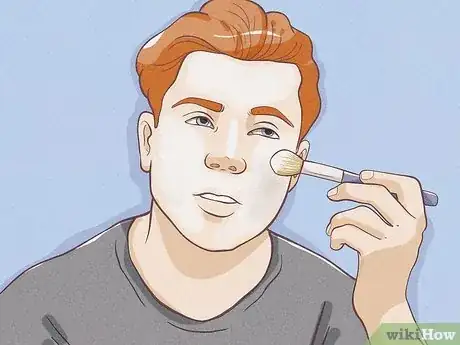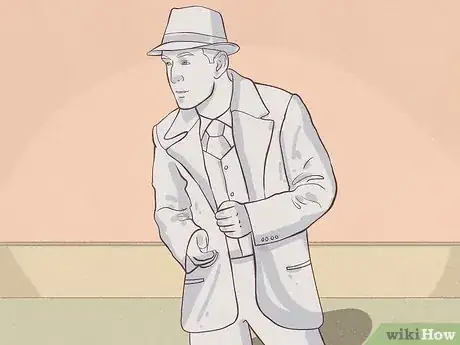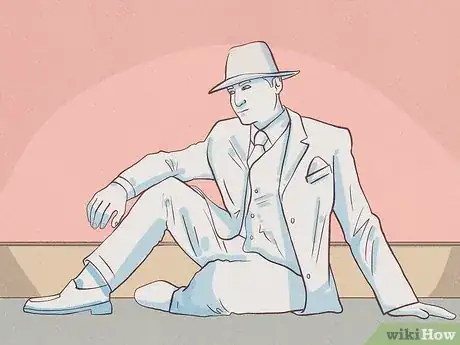This article was co-authored by wikiHow Staff. Our trained team of editors and researchers validate articles for accuracy and comprehensiveness. wikiHow's Content Management Team carefully monitors the work from our editorial staff to ensure that each article is backed by trusted research and meets our high quality standards.
This article has been viewed 256,300 times.
Learn more...
Human statues have a long history in the European street theater tradition. In many large cities worldwide, you can see human statues busking for money with great patience and physical control. If you would like to become a living statue, you’ll need to decide on your theme and create a costume, then practice keeping still on a public street or square.
Steps
Creating a Character and Costume
-
1Develop a character. The character can be based on a real person or well-known literary or mythological character, or created along common character tropes. Common character ideas include: robots, astronauts, literal statues (e.g. “The Thinker”), and mimes.[1]
- For ideas or inspiration, look through pictures of living statues online, or go to an area of a nearby city in which living statues frequently perform.
-
2Make a costume. Start by visiting costume stores or novelty shops to find the necessary wigs and clothing for your costume. If you’d like to custom make your own costume, you can visit a fabric store to purchase an appropriate color and style of fabric, and then sew your own costume.[2]
- If you have the option, choose a cotton fabric for your costume. Cotton holds its color well, even if you’re performing in rain or snow.
Advertisement -
3Accessorize your character. To flesh out your appearance as a human statue, you can accessorize with objects to wear and hold.[3] Look for objects that match your overall theme: if you’re a robot, hold an imitation computer; if you’re a statue, hold a book to “read”; if you’re a pirate, hold a plastic sword and hook.
- Sometimes just going shopping will be enough to inspire the costume, character, and actions you choose to perform. Yard sales, thrift shops and antique shops are best. You’re bound to find something odd that will spark your inspiration.
- Other helpful places for props are home improvement stores (if you’re looking for mechanical items) and fabric and craft stores. Items found at these types of stores may spark your creativity and give you ideas of how to accessorize your statue character.
-
4Apply makeup to flesh out your character. Many living statues cover themselves completely in makeup, to give them the appearance of being a statue, robot, or other non-human character. Depending on your natural skin tone, white makeup works best; copper and silver are other popular face-paint colors.[4] You should be able to find costume makeup at a costume or hobby store, or through most online retailers.
- If using a white or non-metallic color, use water based cake-makeup as opposed to oil based. If you use oil, dust it with a finishing powder so it doesn’t smudge.
- In order to draw attention to your eyes, you may want to line them in brown or black with regular eyeliner.[5]
- Adding extra makeup (like lipstick or blush) on top of your solid base may be necessary, but keep it minimal unless the makeup is an essential part of your costume.
Standing as A Living Statue
-
1Find a pose that is easy to maintain. Since you’ll largely be standing still, you need to find an easy pose, at least at first. Exert only a small amount of energy by relying on your bones to hold you up, instead of relying on muscles to keep you in a contorted position. Keep your arms low and close to your body, feet shoulder-width apart, and avoid contorting your torso.[6]
- Don’t force yourself to balance in an uncomfortable position. If you’re just starting out, you could even incorporate a chair or the wall of a building into your positions, to help support your body weight.
- As you become more used to working as a living statue, you’ll develop patience, and you’ll learn to ignore small distractions from your body, including minor itches or a building sneeze.
-
2Change your pose often. Although a practiced living statue can hold a single pose for over two hours, a beginner will find it difficult to hold a pose for 15 minutes. You can make gradual movements to switch poses: lower or raise your arms, bend at your waist, straighten your back, or try innovating new positions on your own. Shifting poses frequently will prevent you from developing cramps or falling over.
- Conversely, sudden and dramatic movements can take your audience by surprise and wow them. By interspersing dramatic arm and torso movements into your living-statue routine, you can give yourself opportunities to move and to further engage the audience.
-
3Breathe deeply and without movement. Control your breathing when you’re trying to hold a pose for a long period of time. Breathe deeply and slowly into your abdomen, then your chest. As your breaths slow, it will create the illusion of total immobility, which will impress audience members.
- For some living statues, the experience of standing perfectly still and breathing slowly can begin to feel like meditation. Time can pass quickly in this state, so don’t forget to look at your watch from time to time.
-
4Choose an action to perform. When a human statue comes to life, it’s common for the performer to perform an action or give something away.[7] What you give away doesn’t have to be tangible; it can be something as simple as a glance or gesture. However, your action or gesture needs to be meaningful; it should be a moment in which you connect with the human being in front of you and look them in the eye.
- If you have a talent, use it. For example, you can draw in viewers and surprise audience members by blowing bubbles, creating origami, performing coin tricks, or playing an instrument.
- If someone leaves money, you can surprise them by performing an action: blow a kiss, tip your hat, or take a dramatic bow.
Interacting with Audience Members
-
1Select a good location to perform as a statue. If you’d like to be seen by as many passers-by as possible (and consequently receive as many tips as possible), you’ll need to select a location with a high level of pedestrian traffic. Street performers commonly set up along walking malls, large sidewalks and street corners, or in large public parks or gardens. Make sure to avoid areas where “No Busking” signs are prominently posted.[8]
- You’ll also need to confirm that you can legally perform and solicit money in the area that you select. Generally, busking is legal on public property. Most large cities will have publicly available busking guidelines posted online. Consult these, or speak with other buskers to determine where you can and cannot perform.[9]
-
2Set out a hat or bucket for money. Living statues often work as buskers and rely on their performance as a part of their income. Passing pedestrians who appreciate your costume and talent will often linger and join other individuals to watch you in full statue costume. If you have a hat, bucket, or jar set out, appreciative audience members will drop in money.[10]
- If you’re only planning to perform as a living statue as a hobby and don’t want to make an income from the work, you don’t need to put out a collections bucket.
-
3Do not scare or jump towards children in the audience. Resist the urge to jump out at toddlers and young children to startle them. The idea of a large grey statue coming to life and frightening a child could potentially give them nightmares. If you treat your audience members—especially children—with hostility, your audience will soon stop giving you money.
- Some people dislike being near living statues and find them creepy due to their realism. If anybody complains, simply inform them that you are doing this as performance art, not to try to disturb people.
-
4Protect your personal space from hecklers. Unfortunately, some individuals find it funny to harass, heckle, or otherwise bother and assault living statues. There are various ways that living can statues can discourage hecklers and protect themselves from hasslers.[11] You can try various techniques, and find one that works for you and your costume.
- For example, when dealing with unruly teenagers or adults, jumping out and scaring them away can be a defense that allows you to stay in character. This applies to any people who try to touch you or generally treat you poorly.
-
5Speak to hecklers if they continue to hassle you. If you have tried to discourage hecklers while staying in character, you may need to break character and speak to persistent hecklers. Although performers try to stay in character for a long as possible, it’s worth breaking character to protect your personal space and keep from potentially being assaulted.[12]
- If someone continues to try to touch your or hassle you, try saying something like, “This isn’t funny and you’re making me uncomfortable, please stop hassling me.”
Community Q&A
-
QuestionHow can I find out what permits I might need?
 Community AnswerVisiting your town's website or calling city hall's permit department should provide you an answer, as well as information on where to obtain any permit needed and its cost.
Community AnswerVisiting your town's website or calling city hall's permit department should provide you an answer, as well as information on where to obtain any permit needed and its cost. -
QuestionHow do I get my school friends to stop making me laugh while I'm being a living statue?
 Community AnswerRead the article on how to keep a strait face or bite your tongue. Or tell them to stop.
Community AnswerRead the article on how to keep a strait face or bite your tongue. Or tell them to stop.
References
- ↑ http://busk.co/blog/busking-tips-tricks/make-human-statue-costume/
- ↑ http://busk.co/blog/busking-tips-tricks/make-human-statue-costume/
- ↑ http://busk.co/blog/busking-tips-tricks/make-human-statue-costume/
- ↑ http://busk.co/blog/busking-tips-tricks/make-human-statue-costume/
- ↑ http://www.broadwaytovegas.com/August19,2007.html
- ↑ https://asilentsoapbox.wordpress.com/category/how-to-be-a-statue/
- ↑ http://www.telegraph.co.uk/culture/6005028/Living-statues-the-art-of-not-falling-over.html
- ↑ http://www.telegraph.co.uk/culture/6005028/Living-statues-the-art-of-not-falling-over.html
- ↑ http://buskinlondon.com/code
- ↑ http://www.telegraph.co.uk/culture/6005028/Living-statues-the-art-of-not-falling-over.html
- ↑ https://asilentsoapbox.wordpress.com/category/how-to-be-a-statue/
- ↑ https://asilentsoapbox.wordpress.com/category/how-to-be-a-statue/
- ↑ http://www.telegraph.co.uk/culture/6005028/Living-statues-the-art-of-not-falling-over.html






































































